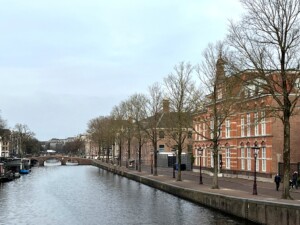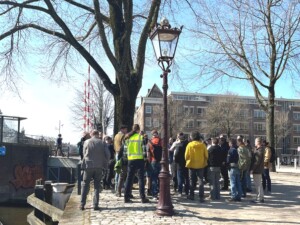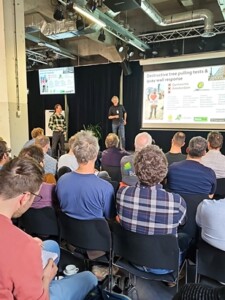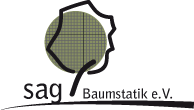The 23rd workshop of the SAG tree statics expert working group was dedicated to the topic of the structural interaction of trees and retaining walls, which can be quay walls, excavation pit shoring or other walls with one-sided embankment and nearby trees. The workshop took place on 21 March 2025 in Amsterdam. That city has around 600 kilometres of quay walls to maintain along its numerous canals, and is therefore well suited to discussing this topic. The workshop was attended by 63 people from various countries.
 Photo: Site view of a typical site situation in Amsterdam – elm trees along a quay wall.
Photo: Site view of a typical site situation in Amsterdam – elm trees along a quay wall.
Situation in Amsterdam
Cees de Boer, an employee of the City of Amsterdam, kicked off the event. He illustrated how the situation of trees on the city’s quay walls has developed historically. De Boer explained that almost exclusively elms grow there; there would be around 75,000 trees of this type in Amsterdam alone.
De Boer went on to explain that sections of quay wall regularly have to be replaced as part of maintenance work, which is a particular challenge when the root zone of nearby trees is affected. Machines specially developed for this purpose are used to replace the wall as gently as possible. Sometimes the trees are temporarily transplanted if the quay wall needs to be replaced. This is particularly practical for smaller specimens. The city has created an area for the temporary storage of those trees, which is jokingly referred to as the ‘tree campsite’. In addition to the challenge of not damaging the tree roots during such construction work, the question regularly arises as to whether the anchoring strength of the trees is dependent on the presence of the quay wall.
This question was also addressed by Matthijs Griffoen, head of the ‘Trees on quay walls’ team of the City of Amsterdam, in his subsequent presentation. As the root zone directly next to the quay walls in Amsterdam consists mainly of sand and is therefore very unattractive for root growth, the tree roots occasionally grow into the quay walls. Griffoen surmises that not only are the trees statically adapted to the presence of the quay wall, but that the tree roots also hold up the wall, so the stabilising effect might be mutual. He presented his ideas for a more innovative construction of the quay walls, which would ensure longer-term stability and allow partial replacement of the wall’s supporting elements with less effort.
Calculation approach for the load exerted on the wall by the tree
Prof Frank Prietz of the Berlin University of Applied Sciences and co-managing director of GSE Ingenieur-Gesellschaft mbH, Berlin, then presented an engineer’s calculation approach to estimate the load exerted by trees on retaining walls (see PRIETZ et al. 2022). He emphasised the difficulty of this approach in that many disciplines were intertwined and there was no previous research or reliable publications on which to build. As it was necessary to rely on estimated values for many input variables, high safety margins were taken into account. If more precisely estimable parameters were available, e.g. the load-bearing capacity of the surrounding soil could be better modelled, this would result in lower calculated loads. This would be conducive to a material-saving wall construction and favourable for the evaluation of the respective tree with regard to the load on the structure. However, further research is required to specify the assumptions.
Measurements on tree and quay wall
In the second half of the event, Jan Hilpert (Dendrologic), Dennis de Goederen (Pius Floris) and Roel Geerts (Terra Nostra) presented the results of various measurements that could be used to draw conclusions about any mutual anchoring of tree and quay wall. Only elms of different species and varieties were analysed.
– Using the pulling test method, both the trunk base inclination and the simultaneous movements of the neighbouring quay wall were recorded for five trees under controlled load application and compared in the subsequent evaluation.
– In a further test, the trunk movements of the same five trees and the movements of the wall were recorded and compared using wind reaction measurements (with tree motion sensors) during a storm event in July 2024.
– In addition, quay wall sections which had to be renewed were completely removed at ten tree sites and the stability of the trees was then measured using the pulling test method. The possibilities of root protection for such massive site interventions were also considered.
– Finally, four elm trees, which had been earmarked for felling by the city of Amsterdam for structural reasons, were loaded in a pulling test until failure. The movement of the quay wall was recorded simultaneously in this test setup, which was intended to allow conclusions about damage to the wall structure caused by the uprooting of trees.
Final discussion
Even though the participants contributed their lively questions and ideas throughout the presentations, an open discussion marked the official conclusion of the event. The advantages and weaknesses of the methods used were discussed and various interpretations of the results were weighed up against each other.
Overall, the results indicate that the dependency between the root system and the wall construction of the elms analysed is significantly less pronounced than initially assumed.
It is clear that the measurements cannot provide scientifically robust statements due to the small number of trees and cannot be generalised in view of the different nature of soils and retaining wall constructions. Nevertheless, the measurement results provide initial insights and a basis for hypotheses that should be verified by further investigations. The specialists from various disciplines are still working together on improvements and there are already initial plans for new series of measurements.
The measurements were commissioned by the City of Amsterdam with the aim of developing recommendations for further handling of tree inspections and quay wall maintenance based on the results. After the results have been fully evaluated, it is planned to publish them.

Photo: The topic was illustrated by viewing a case study.

Photo: J. Hilbert and D. de Goederen present the results of movement measurements on trees and quay walls
The program can be found here: Program


